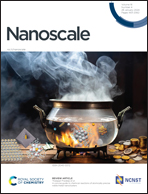A motif for B/O-site modulation in LaFeO3 towards boosted oxygen evolution†
Abstract
Here, a series of transition metal (Ni) doped iron-based perovskite oxides LaFe1−xNixO3−δ (x = 0, 0.25, 0.5, 0.75, 1) were prepared, and then the perovskite oxide with the optimized nickel–iron ratio was doped with non-metallic elements (N). Experimental and theoretical investigations reveal that the co-doping breaks the traditional linear constraint relationship (GOOH − GOH = 3.2 eV) and the theoretical overvoltage is reduced from 0.64 V (LaFeO3−δ) to 0.44 V (LaFe0.5Ni0.5O3−δ/N). Specifically, Ni-doping can accelerate electron transfer and improve the conductivity. Moreover, N-doping can reduce the adsorption energy of *OH/*O and enhance the adsorption energy of *OOH. We demonstrated that the optimized cation and anion co-doped LaFe0.5Ni0.5O3−δ/N perovskite oxide exhibits an excellent OER performance, with a low overpotential of 270.6 mV at 10 mA cm−2 and a small Tafel slope of 65 mV dec−1 in 1 M KOH solution, markedly exceeding that of the parent perovskite oxide LaFeO3−δ (300.9 mV) and commercial IrO2 (289.1 mV). It also delivers decent durability with no significant degradation after a 35 h stability test. This work reveals the internal mechanism of perovskite oxide by doping cation and anion for water oxidation, which broadens the idea for the rational design of new perovskite-based sustainable energy catalysts.



 Please wait while we load your content...
Please wait while we load your content...